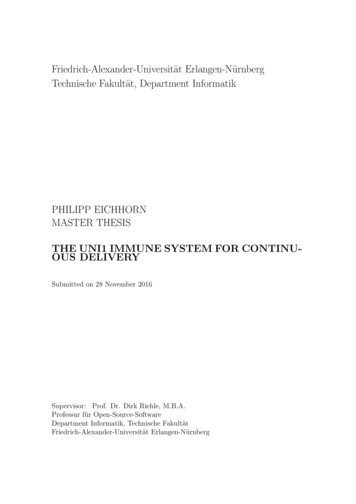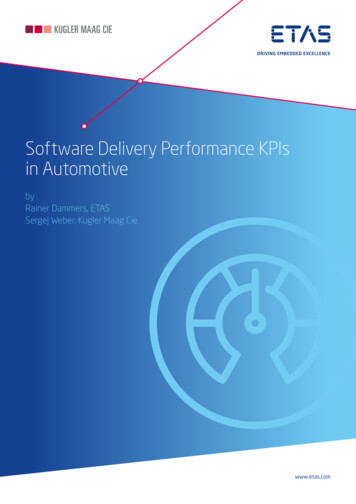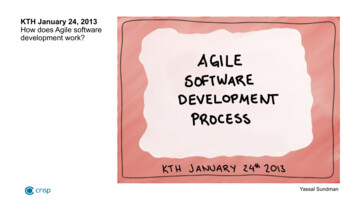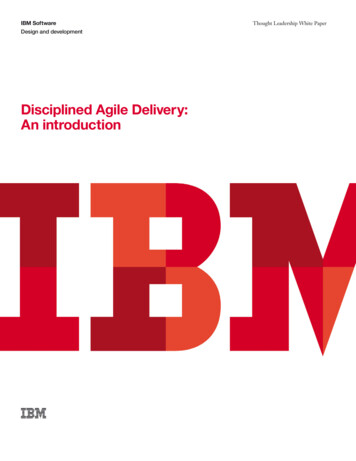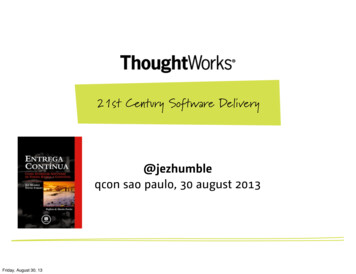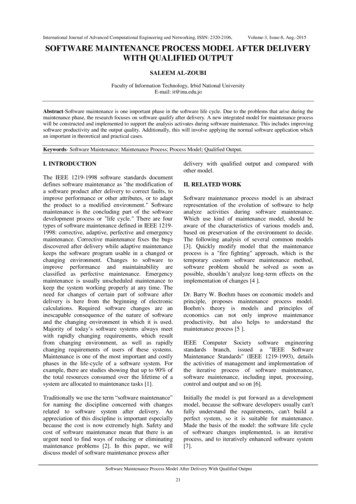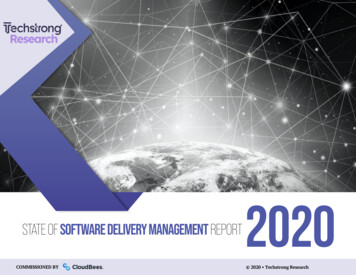
Transcription
STATE OF SOFTWARE DELIVERY MANAGEMENT REPORTCOMMISSIONED BY2020 2020 Techstrong Research
STATE OF SOFTWARE DELIVERY MANAGEMENT REPORT 2020CONTENTSABOUT THIS REPORT. 3EXECUTIVE SUMMARY. 4INTRODUCTION. 6WHAT IS SOFTWARE DELIVERY MANAGEMENT (SDM). 7WHY IS SDM IMPORTANT?. 8THE IMPACT OF SOFTWARE DELIVERY MANAGEMENT. 9HOW SOFTWARE DELIVERY MANAGEMENT CAN HELP. 10Quantify The Impact Of Investment In Software Delivery.11Capability of Software Delivery Teams to Communicate and Collaborate.12End-To-End Visibility Into The Value Flow Of Software Delivery Streams.13THE ACCELERATED STRATEGIES GROUP VIEW. 14SURVEY DEMOGRAPHICS. 14COMMISSIONED BY2
STATE OF SOFTWARE DELIVERY MANAGEMENT REPORT 2020About the authorAbout this reportSanjeev Sharma is a co-founder andPrincipal Analyst at AcceleratedStrategies Group. He focuses onDevOps, Application Modernization,DataOps, and Cloud Adoption.Sanjeev is a practitioner by trade,and has served as Distinguished Engineer and CTO ofDevOps Adoption at IBM and Field CTO at Delphix.He is the author of two best-selling books – DevOpsFor Dummies, IBM Edition, and The DevOps AdoptionPlaybook. Sanjeev is a sought-after analyst, advisor andconsultant who works with senior executives leading largescale transformations and speaks often at technologyconferences and online events. He also writes a popularblog (http://sdarchitect.blog).This report, commissioned by CloudBees, is based on extensiveresearch conducted by Accelerated Strategies Group to assess thecurrent state of Software Delivery Management (SDM) and examinethe impact of SDM adoption as a strategy. Accelerated StrategiesGroup fielded a survey and conducted one-on-one interviews with keyindustry leaders and experts to gather and further refine the data onwhich this report is based.Sanjeev can be reached at: sanjeev@accelst.com or athttps://accelst.com/sanjeevsharma/.About Accelerated Strategies GroupACCELERATED STRATEGIES GROUP is out to democratize access to industryexpertise and knowledge. Our expert analysts leverage their experience-basedknowledge to deliver insightful, intelligent, and actionable information aboutdigital transformation, DevOps, cloud-native and cybersecurity to IT and productorganizations. Like open source software, we widely share our work products forfree because we believe Knowledge Wants To Be Free.Contact ASG at info@accelst.com and get more great research, reports, commentary,videos and more at https://accelst.com.COMMISSIONED BY3
STATE OF SOFTWARE DELIVERY MANAGEMENT REPORT 2020Executive SummaryTHE ABILITY TO effectively and efficiently deliver software is a prerequisite for business success today.Organizations leverage software to deliver not just core business value to users and customers, but alsoas a mechanism to disrupt markets, compete for new customers and develop new revenue streams.The ability to deliver high-quality software in a timely and cost-effective manner is not, however, a competency for mostorganizations. Most struggle with lean and efficient Software Delivery Management (SDM), primarily because of the sheer sizeand complexity of applications and systems, developed by distributed teams, leveraging multiple technology stacks, across poorlyintegrated, but highly interdependent application delivery pipelines. This complexity impedes agility and results in a lack ofvisibility into the application delivery pipelines and the work being delivered by practitioners. This, in turn, results in organizationalleadership making investments into software delivery without the insights they need to make data-driven decisions.In order to understand the current state of SDM in the industry, Accelerated Strategies Group conducted a research studysurveying software delivery practitioners, leaders, and executives across the industry. This report presents the findings of theresearch, and the inferences and recommendations Accelerated Strategies Group has concluded from the data gathered.SDM is still a new approach. Its practices are still evolving and gaining traction. However, our findings from this researchstudy make a strong case for increasing SDM adoption in organizations looking to enhance their ability to deliver software.SDM strategies address the key challenges we found most organizations struggling with, including their maturity, agility andtheir ability to react quickly to market changes and competitive pressures. SDM gives organizations the necessary tools toleverage software delivery to succeed with their own digital transformations.The key challenges SDM can address and mitigate include, first and foremost, organizations’ inability to properly quantify theimpact of investments in software delivery. This results in businesses investing haphazardly, without a clear breakdown ofwhere the investments were adding value, or where additional, targeted investments could fill gaps in their capabilities. ›››COMMISSIONED BY4
STATE OF SOFTWARE DELIVERY MANAGEMENT REPORT 2020Executive Summary, continuedThe second key area SDM can address is enhancing the ability of software delivery teams to communicate and collaborateas they deliver software. Even a decade after the DevOps movement highlighted the negative impact of functional andorganizational silos in organizations, our research found that a majority of the organizations still have such silos; silosseverely impact the ability of practitioners and teams to collaborate and communicate at scale.Finally, our research showed that SDM can provide end-to-end visibility into the value flow across application deliverypipelines and software supply chains. Teams, and in many cases, teams of teams of software development practitioners,collaborate to create and deliver software. These practitioners, their managers, and business leaders need visibility into thedata and insights not just across their own projects’ application delivery pipelines, but in most cases, across multiple pipelinesand value streams, to better perform their jobs and to make data-driven decisions.The root causes of these challenges range from organizational silos, to software tool sprawl, to a culture that does not fostercommunication and collaboration and free flow of data.This report explores how SDM can help organizations more effectively and efficiently manage software delivery, and, basedon the results of our research, provides evidence that adopting SDM strategies can help mitigate the challenges, and improveyour organization’s ability to deliver software in a lean and agile manner.COMMISSIONED BY5
STATE OF SOFTWARE DELIVERY MANAGEMENT REPORT 2020IntroductionMany organizations facemultiple interdependentsupply chains and valuestreams, deployedacross hybrid and multicloud environments,developed and deployedby distributed teamsof software developersusing a variety oftechnology stacksthat get in the way ofeffective, efficientsoftware delivery.ORGANIZATIONS must pivot and adapt quickly to changing conditions; agility, or lack thereof,is the difference between success and failure. Today, organizations old and new are embracing aprocess of digital transformation to help them win, serve and retain their customers.Truly disruptive organizations understand that agile software delivery pipelines are at the heart of their digitaltransformation. However, while some organizations may understand this in theory, in practice the situationlooks very different for most.Many organizations face multiple interdependent supply chains and value streams, deployed across hybrid andmulti-cloud environments, developed and deployed by distributed teams of software developers using a varietyof technology stacks that get in the way of effective, efficient software delivery.The complexity of managing these multiple, concurrent supply chains and value streams as well as thesoftware development practitioners themselves, creates the polar opposite of agility. Not only are businessesunable to qualify and quantify where and how value is delivered, they’re unable to properly determine whereto make tactical and strategic investments that could address the inefficiencies in their software deliveryprocesses as a whole.For decades, Agile methodologies have been adopted to counteract the inefficiencies and obstacles inherentin the software development process; a decade ago, DevOps promised to do the same for the development andoperations teams. While these two approaches have enabled significant progress in making software deliveryleaner and more efficient, there remain critical flaws and gaps in most organizations’ ability to deliver software,from a technology and skills perspective as well as at the organizational level, within team modeling structuresand on cultural fronts.Accelerated Strategies Group conducted this primary research to assess the current state of the softwaredelivery management at organizations across company size, industry, and geographic location.COMMISSIONED BY6
STATE OF SOFTWARE DELIVERY MANAGEMENT REPORT 2020IntroductionDEFINITIONWhat is Software Delivery Management?The definition of SDM has evolved over time,focusing on enhancing the ability of practitioners,and the businesses and organizations they workfor, to deliver software applications and systemsin a lean and efficient manner. The author of thispaper has the following simplified definition ofSDM:SOFTWARE DELIVERY must be a core competency for any organization orteam responsible for delivering business value via software applications andsystems. Regardless of the technology stack, development platform (cloudvs. on-premise), and level of customization (completely customized vs.packaged, off-the-shelf technology), the ability to deliver these applicationsand systems cost-effectively and efficiently, with well-defined successmetrics and key performance indicators (KPIs), is a core goal of all softwareorganizations.entSoftware Delivery Managem(soft wԑәr di liv ә ri mæn idӡ mәnt)ctices, andThe set of aligned processes, prat allow allorganizational structures thainformation,teams to have visibility, shareults inand collaborate better. This restions andthe delivery of software applicaefficientsystems in a more effective andnableway with predictability and defibusiness value.lyst,– Sanjeev Sharma, Principal AnaAccelerated StrategiesCOMMISSIONED BYBusinesses’ ability to deliver software is now a prerequisite to compete effectively in themarket. Hence, organizations have made significant investments aimed at enhancing theirability to deliver software. Software Delivery Management (SDM) as a term has evolvedover the last few years to describe and represent an organization’s ability to streamlineprocesses, enable tighter collaboration, and provide universal insights, through sharedinformation, into all aspects of software delivery.7
STATE OF SOFTWARE DELIVERY MANAGEMENT REPORT 2020Why is SDM Important?A WELL-DEFINED SDM STRATEGY canaddress the major challenges faced by thesoftware delivery practitioners, IT management,product stakeholders, and executive leadership.The respondents to the Accelerated StrategiesGroup survey extended across the entirespectrum of stakeholders. The respondentshighlighted several critical challenges that couldbe alleviated with the adoption of SDM.These findings are symptoms of a larger problem:organizations are still early on their journey to adoptSDM. Progressing on their SDM adoption journey can helporganizations tackle all of these challenges and acceleratedigital transformation by addressing:1. Technology rationalization and modernization2. Process improvement3. Organizational change and4. Cultural transformation.COMMISSIONED BY65 35 S65%The significant majority (65%) of respondentsare unable to accurately quantify the cost offeature delivery delays.We found a significantcommunication gap betweenlayers of management,indicating that information isnot flowing vertically withinorganizations85 15 S84% Organizational and functional silos impedethe free flow of information to practitionersand senior leadership. More than 84%of respondents said the inaccessibility ofinformation got in the way of their ability to dotheir jobs and/or make data-driven decisions.‘Software sprawl’ is rampantand also hinders datadriven decision making asmultiple technology stacks,across multiple generationsof technologies, remain inuse across organizations.This also negatively impactscollaboration.While the survey showedsmall organizations(1-99 employees) andlarge enterprises (5,000 employees) have madeprogress implementingstrategies to enhance the freeflow of information acrossteams, mid-sized companies’progress is not as evident.8
STATE OF SOFTWARE DELIVERY MANAGEMENT REPORT 2020The impact of SoftwareDelivery ManagementWE HAVE SEEN EVIDENCE that manyorganizations have been able to tackle someof the facets of modern software deliverymanagement, as evidenced by those listed here.However, there is still a lot of room forimprovement for most organizations, as theyprogress on adopting SDM strategies.COMMISSIONED BY67%A significant majorityof organizations (67%)are able to prioritize thedevelopment of featuresbased on expectedbusiness impact.63%Surprisingly, 63% oforganizations todayinclude plans to‘promote and articulate’the value of newfeatures released toend-users.61%In addition, a majorityof respondents (61%)said SDM shortenedlead time for featuredelivery. Lead timeis a key metric formeasuring the softwaredelivery maturity of anorganization, so thisshows a positive impact.9
STATE OF SOFTWARE DELIVERY MANAGEMENT REPORT 2020HOW Software DeliveryManagement can helpADOPTING Software Delivery Management strategies addresses the gaps and inefficiencies in anorganization’s ability to deliver software.Based on our research, we’ve identified three key strategies to help organizations increase their software deliveryefficiency and effectiveness: organizations must quantify the impact of their investment in software delivery;organizations must enable software delivery teams to communicate and collaborate effectively and efficiently; andorganizations must have end-to-end visibility into the value flow of their software delivery streams.COMMISSIONED BY Quantify the impactof investment insoftware deliveryCapability of softwaredelivery teams tocommunicate andcollaborateEnd-to-end visibilityinto the value flowof software deliverystreams10
STATE OF SOFTWARE DELIVERY MANAGEMENT REPORT 2020 Quantify the impact of investmentin software deliveryREGARDLESS OF ORGANIZATION SIZE, the research showed most softwaredelivery teams are not able to quantify the impact of investments they havemade to their ability to deliver software.The inability to break down the costs of delivering software, the inability to quantify themonetary impact of software delivery delays, and the inability to trace the cost of defectsto business impact all result in a lack of visibility into the software delivery value stream.Businesses are investing in software delivery without a clear understanding of where value isbeing added or subtracted. Without this information, they are unable to properly determinethe benefits and/or drawbacks of past or future investments.The ability to track what tasks developers spend time on – developing new features vs. fixingdefects or retiring technical debt—is a key measure of the maturity of a team’s ability to deliversoftware. It’s also a measure of the maturity and quality of the software delivered itself. Theresearch found that more than 50% of respondents do not compare developers’ time spent on newfeature development vs. time spent on retiring technical debt. Not being able to measure whereyour developer’s time is being spent is, in and of itself, a blind spot that needs to be addressed.Adopting effective SDM strategies addresses these issues, providing businesses the ability toeffectively make decisions on where in the value stream to invest, and to quantify the impact oftheir investments.COMMISSIONED BY52 48 S50% More than 50% of survey respondents Cannot break down the cost ofapplication development byfunctional area. Are unable to accuratelycalculate the business impactof feature delays. Cannot measure the cost ofdefects found after release.11
STATE OF SOFTWARE DELIVERY MANAGEMENT REPORT 2020SDM can help organizations facilitate communication and collaboration across functionalareas in software delivery pipelines, and across interdependent software delivery pipelines.It’s necessary for teams to work with development and delivery tools from across the spectrumof commercial and open source models, including SaaS. But that doesn’t have to lead to sprawlor integration challenges; organizations should seek out best-of-breed suites and platformsthat include vendor integration support and/or solutions that work seamlessly together out ofthe box.Furthermore, SDM strategies can also transform organizational culture by introducing a jointsense of ownership and pride in delivering value, not just functionality, to end-users andcustomers.COMMISSIONED BY More than 60% ofsurvey respondents saidfunctional silos still existin their organizations.More than 85% of surveyrespondents said silosimpede the free flow ofinformation across theorganization.SOFTWARE SPRAWL is a major challenge.When asked to choose which of severalsoftware options were used in theirorganization’s technology stacks, 31% of allrespondents chose50%‘all of the above’:commercial software,40%open source software,and software-as-a30%service (SaaS). Theproblem is worse for20%large enterprises(5,000 employees),10%with 44% choosing“all of the above.”All of the aboveLarge enterprisesSOFTWARE DELIVERY is a team sport. Teams, and teams of teams,distributed across geographies and time zones need to work together in smallsquads and larger tribes to deliver the distributed, complex systems thatrun modern businesses. SDM strategies facilitate this communication andcollaboration of teams.62 38 S 86 14 S85% All respondents Capability of software deliveryteams to communicate andcollaborate60% 12
STATE OF SOFTWARE DELIVERY MANAGEMENT REPORT 2020 End-to-end visibility into the valueflow of software delivery streamsSOFTWARE DELIVERY is now a data-driven activity, and data needed bysoftware practitioners, by the leadership and executives should be accurate andfreely accessible to allow them to more easily do their jobs, make data-drivendecisions and provide the full picture of the current state of software deliverypipelines.Our research tells us that data remains locked in tool-specific data stores and often isn’tintegrated with other tools in the software delivery pipelines. Even data extracted from thesetools and stored in dashboards and data warehouses isn’t often used efficiently or effectively.The primary cause of this is tool sprawl, and the secondary cause is organizational culture.SDM strategies address these issues through the emphasis on both adopting the righttechnologies to enable the free flow of data, and on cultural change to allow for the data to beaccessible to the right practitioners and decision makers such that it can be used effectively tomake data-driven decisions.COMMISSIONED BY52 48 S50% More than 50% of survey respondents Do not have access to goodquality data from across thetool chain. Do not have access to datafrom tools across multipleapplications and projects.13
STATE OF SOFTWARE DELIVERY MANAGEMENT REPORT 2020SURVEY DEMOGRAPHICSThe Accelerated Strategies Group ViewThe Accelerated Strategies Group survey for thisresearch was conducted between April 19 and May31, 2020. We gathered 153 completed responses.TO SUCCESSFULLY EXECUTE a digital transformation strategy, it’simperative that organizations adopt SDM strategies. Our research,supported by extensive survey data, validates Accelerated Strategies Group’shypotheses that there remain critical flaws and gaps in the software deliverymaturity of most organizations, and that SDM can remediate these flaws andfill in these gaps.?Responses represented nine countries.Respondents have a variety of roles and comefrom a broad spread of organizational sizes47% of respondents came from smallorganizations ( 1,000 employees) 470 530 350 650 390 610 80 520 390 35% of respondents represent largeorganizations ( 5,000 employees)39% self-identified asindividual contributorsOrganizations that have or are in the process of enabling SDM strategies are maturingat a much faster rate, and are clearly reaping the quantity, quality and efficiency benefitsthat SDM can provide across software delivery pipelines. We suggest that organizationsadopt these practices, tools and cultural principles that enable effective SDM to bring theirorganizations a competitive advantage. We expect this to become more mainstream in thecoming months and years, and that SDM will continue to grow as an organizational strategicimperative. That being said, SDM as a set of strategies and approaches is itself is stillevolving and will continue to do so as the industry matures. With that maturity will comeeven more new technologies, more complexities, and greater nuances as to how they areadopted and leveraged.61% self-identified as managers orleadership (8% C-suite executives)COMMISSIONED BY14
DevOps, Application Modernization, DataOps, and Cloud Adoption. Sanjeev is a practitioner by trade, and has served as Distinguished Engineer and CTO of DevOps Adoption at IBM and Field CTO at Delphix. He is the author of two best-selling books - DevOps For Dummies, IBM Edition, and The DevOps Adoption Playbook.
